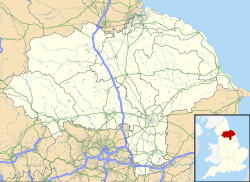Jervaulx Abbey facts for kids

Jervaulx Abbey ruins
|
|
| Monastery information | |
|---|---|
| Order | Savigniac, Cistercian |
| Established | 1156 |
| Disestablished | 1537 |
| Mother house | Byland Abbey |
| Dedicated to | St Mary |
| Diocese | York |
| Controlled churches | Aysgarth, Ainderby Steeple, East Witton, West Witton |
| People | |
| Founder(s) | Akarius fitz Bardolph |
| Site | |
| Location | East Witton, North Yorkshire, England |
| Coordinates | 54°16′1″N 1°44′17″W / 54.26694°N 1.73806°W |
| Visible remains | Substantial |
| Public access | Yes. Privately owned. |
Jervaulx Abbey is an old Cistercian abbey found in East Witton, a village in North Yorkshire, England. It is about 14 miles (22 km) north-west of the city of Ripon. The abbey was built in 1156 and was dedicated to Saint Mary. Today, its ruins are a very important historical site, known as a Grade I listed building.
The name Jervaulx comes from French. It means 'the Ure valley'. This valley is now called Wensleydale.
Contents
History of Jervaulx Abbey
Jervaulx Abbey started as a Savigniac monastery. This was a type of religious order from Normandy, France. Later, the abbey was taken over by the Cistercian order from Burgundy, another region in France. Byland Abbey became responsible for it.
Building the Abbey
The abbey was first built in 1145 at a place called Fors, near Aysgarth. Ten years later, in 1155, it was moved a few miles away. The new spot was better, right by the River Ure.
In 1145, during the time of King Stephen, a lord named Akarius Fitz Bardolph gave land to a monk named Peter de Quinciano. Peter was from Savigny Abbey. He wanted to build a monastery for his order at Fors and Worton in Wensleydale. This first monastery was called the Abbey of Fors. It was also known as Jervaulx and Charity. The original site is now called Dale Grange, or just The Grange.
Challenges and Growth
The head of Savigny Abbey, Abbot Serlo, was not happy about the new monastery. It had been started without his permission. He refused to send more monks from his abbey to England. So, it was decided that Byland Abbey would help the new monastery instead.
Monks from Byland Abbey faced many difficulties at first. The land was not very rich, and they did not have much money. But then, Conan, a powerful duke, gave them more money. In 1156, he helped them move the monastery to its better location in East Witton.
Here, the monks built a new church and other buildings. Like most Cistercian monasteries, it was dedicated to Saint Mary. When the abbey was at its best, it owned half of the valley. It was famous for breeding horses, a tradition that continues in Middleham today. Jervaulx Abbey was also where Wensleydale cheese was first made. It was originally made from sheep's milk.
End of the Abbey
In 1537, the last abbot, Adam Sedbergh, joined a protest called the Pilgrimage of Grace. This protest was against King Henry VIII's changes to religion. Because of this, Abbot Sedbergh was hanged, and the king took over the abbey's property. This event was part of the Dissolution of the Monasteries.
After the Abbey Closed
After the abbey was closed, some parts of its buildings were used elsewhere. For example, a screen from the abbey can now be seen at St Andrew's Church, Aysgarth. A window was also moved to St Gregory's church in Bedale.
The monasteries were important because they helped many people. They provided jobs and food. When they closed, it caused problems for people in the area.
Today, you can still see many parts of the abbey. These include parts of the church, the buildings where the monks lived, and a watermill. The land around the abbey changed hands many times over the years. In 1971, Major and Mrs. W. V. Burdon bought the abbey. Their youngest son, Ian, now manages the abbey. The ruins are open for people to visit.
Burials at Jervaulx
Some important people were buried at Jervaulx Abbey:
- Akarius Fitz Bardolph - The person who first gave land for the abbey.
- Hugh Fitzhugh, 2nd Baron FitzHugh
- Henry FitzHugh, 3rd Baron FitzHugh and his wife Elizabeth de Gray FitzHugh
Images for kids



